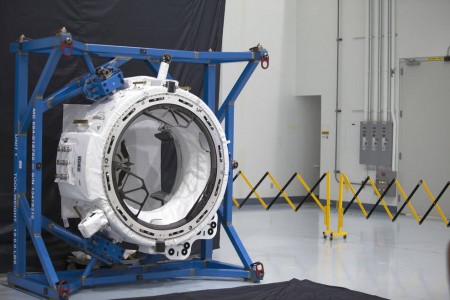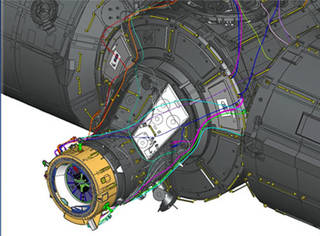July 20, 2016 – On board SpaceX‘s latest Dragon supply mission to the International Space Station (ISS) is a technology that will make it possible for many different types of spacecraft to dock with the low-Earth orbiting laboratory. Called the International Docking Adapter (IDA) it is outfitted with sensors and a software system to automatically perform rendezvous and docking. This has not been the case for commercial supply missions coming to ISS which have required the use of the robotic Canadarm to grab and lock capsules to the main body of the station.
The IDA can operate autonomously but is also equipped for a manual backup override. It is 160 centimeters (63 inches) in inside diameter and externally measures approximately 240 centimeters (94 inches). It is standardized for all existing commercial and national spacecraft operators. The onboard sensors track and link to spacecraft navigation systems making docking an automatic process akin to what we see in science fiction movies. The lack of an international standard would have made the reliance on commercial crew taxis launched from Earth impossible. The first users will be the Boeing Starliner and the Dragon 2.0 spacecraft. Eventually Dreamchaser will also use the IDA. It can also be used by Soyuz. Are there plans to give Chinese spacecraft access to the design standard so that they can adapt their docking mechanisms as well? Considering that the Shenzhou spacecraft is an enhanced version of Russia’s Soyuz it may already be able to use the IDA.
The IDA is a joint-developed project with contributions from the United States and Russia. Two are planned for the ISS. Today when Dragon docks it will first be unloaded before the Canadarm grabs the adapter and maneuvers it into position where a human crew will perform an extravehicular exercise to attach it to the station.
The first attempt to deliver an IDA by SpaceX ended in a catastrophe when the Falcon 9 booster blew up. SpaceX quickly discovered the cause of the failure and since then has seen its Falcon 9s perform flawlessly. In Monday’s launch this week the Falcon 9 not only delivered Dragon into orbit but its first stage performed a quick reversal of course and landed at Cape Canaveral. This was the second successful landing at the Cape and the fifth by Falcon 9 first stages. SpaceX plans to reuse these first stages in future flights with the earliest scheduled for sometime this fall.

















